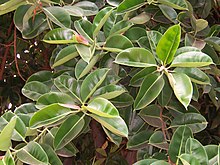Ficus elastica
| Rubber fig | |
|---|---|

| |
| Scientific classification | |
| Kingdom: | Plantae |
| Clade: | Tracheophytes |
| Clade: | Angiosperms |
| Clade: | Eudicots |
| Clade: | Rosids |
| Order: | Rosales |
| Family: | Moraceae |
| Genus: | Ficus |
| Subgenus: | F. subg. Urostigma |
| Species: | F. elastica
|
| Binomial name | |
| Ficus elastica | |
| Synonyms[1] | |
| |
Ficus elastica, the rubber fig, rubber bush, rubber tree, rubber plant, or Indian rubber bush, Indian rubber tree, is a species of flowering plant in the family Moraceae, native to eastern parts of South and Southeast Asia. It has become naturalized in Sri Lanka, the West Indies, and the US state of Florida.[2][3] Despite its common names, it is not used in the commercial production of natural rubber.
Description
[edit]It is a large tree in the banyan group of figs, growing to 30–40 m (100–130 ft) – rarely up to 60 m or 195 ft – tall, with a stout trunk up to 2 m (6 ft 7 in) in diameter. The trunk develops aerial and buttressing roots to anchor it in the soil and help support heavy branches.
It has broad shiny oval leaves 10–35 cm (4–14 in) long and 5–15 cm (2–6 in) broad; leaf size is largest on young plants (occasionally to 45 cm or 17+1⁄2 in long), much smaller on old trees (typically 10 cm or 4 in long). The leaves develop inside a sheath at the apical meristem, which grows larger as the new leaf develops. When it is mature, it unfurls and the sheath drops off the plant. Inside the new leaf, another immature leaf is waiting to develop. The canopy of the tree is dense.
Pollination and fruiting
[edit]As with other members of the genus Ficus, the flowers require a particular species of fig wasp to pollinate it in a co-evolved relationship. Because of this relationship, the rubber plant does not produce highly colourful or fragrant flowers to attract other pollinators. The fruit is a small yellow-green oval fig 1 cm (1⁄2 in) long, barely edible; these are fake fruits that contain fertile seeds only in areas where the pollinating insect is present.
Range
[edit]The natural range of F. elastica extends from Nepal in the north to Indonesia, Bhutan, Northeastern India, Bangladesh, Myanmar, Yunnan in China, and Malaysia. It has been widely introduced in most tropical regions of the world, including Hawaii and the West Indies. In Europe, it can be found in mild locations throughout the Mediterranean Basin.
Cultivation and uses
[edit]
In parts of India, people guide the roots of the tree over chasms to eventually form living bridges.[4] To this day there are large bridges woven from aerial roots in Meghalaya, India. Although the trees used for these bridges are very large, aerial roots can be found on F. elastica as small as 1ft tall.
Ornamental
[edit]Ficus elastica is grown around the world as an ornamental plant, outside in frost-free climates (though it also tolerates light frosts) from the tropical to the Mediterranean and inside in colder climates as a houseplant. Although it is grown in Hawaii, the species of fig wasp required to allow it to spread naturally is not present there.
Most cultivated plants are produced by vegetative propagation. This can be done by cuttings or by layering.
In cultivation, it prefers bright sunlight but not hot temperatures. It has a high tolerance for drought, but prefers humidity and thrives in wet, tropical conditions. Ornamental hybrids (such as Robusta) have been derived from Ficus elastica with broader, stiffer and more upright leaves than the wild form. Many such hybrids exist, often with variegated leaves.
Latex
[edit]All parts of the plant contain an abundant milky white latex, a chemical compound separate from its sap and carried and stored in different cells. This latex was formerly used to make rubber,[2] but it should not be confused with the Pará rubber tree (Hevea brasiliensis), the sap of which is the main commercial source of latex for rubber making. The latex of Ficus elastica has been tested for use in the manufacture of rubber, but without economic and technical results.[citation needed]
Just as with Hevea brasiliensis, the latex of Ficus elastica is an irritant to the eyes and skin and is toxic if taken internally.[5]
Gallery
[edit]-
Illustration from Köhler's Medicinal Plants (1887)
-
An 1854 illustration of Ficus elastica trained as a living bridge
-
Ficus elastica leaf on the left compared to Ficus lutea on the right
-
The figs of F. elastica
-
Ficus elastica near the roadside in Savusavu, Fiji, showing the effects of constant pruning on the growth form.
-
A huge Ficus elastica tree in Ghana showing the aerial roots.
-
Many cultivars, such as this Ficus elastica 'Robusta', are common in the houseplant trade
-
A variegated cultivar
-
Ficus elastica, commonly called the rubber plant.
-
Ficus black
References
[edit]- ^ "The Plant List". Archived from the original on 2019-07-02. Retrieved 2018-03-11.
- ^ a b Zhengyi Wu, Zhe-Kun Zhou & Michael G. Gilbert. "Ficus elastica". Flora of China. Missouri Botanical Garden, St. Louis, MO & Harvard University Herbaria, Cambridge, MA. Archived from the original on 20 April 2017. Retrieved 29 August 2013.
- ^ "Flora of North America, Ficus elastica Roxburgh ex Hornemann, 1819. India rubber plant". Archived from the original on 2018-04-29. Retrieved 2015-08-19.
- ^ "Living Root Bridges". Archived from the original on 2018-06-21. Retrieved 2012-06-19.
- ^ MacDonald, Elvin "The World Book of House Plants" Popular Books










